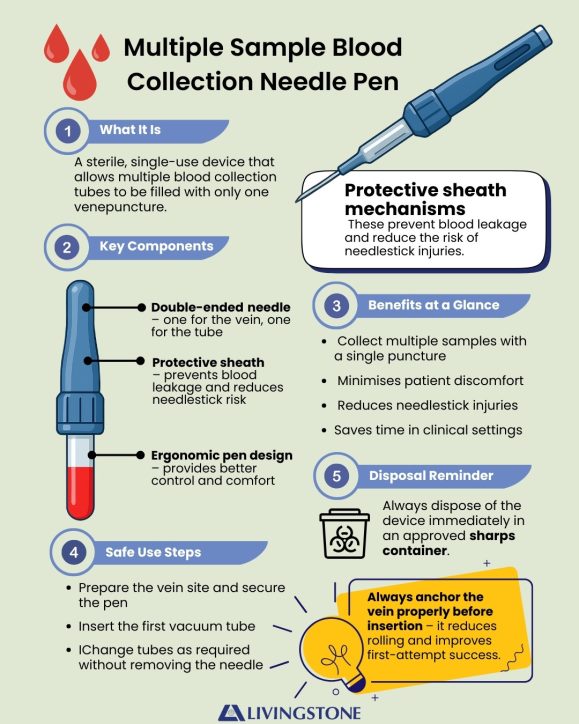Blood collection is one of the most routine yet vital procedures in healthcare, supporting everything from diagnostics to long-term patient monitoring. To make this process efficient, safe, and minimally invasive, healthcare providers rely on devices such as the multiple-sample blood collection needle pen.
Designed for precision and ease of use, it plays a critical role in modern phlebotomy and clinical practice.
This article explores what the device is, how it is used, practical tips for safe application, and best practices for disposal.
What is a Multiple Sample Blood Collection Needle Pen?
A Multiple Sample Blood Collection Needle Pen is a sterile, single-use medical device used in phlebotomy procedures. Unlike single-draw needles, this type is designed for multiple tube collections without the need to puncture the patient’s vein more than once.
The device typically consists of:
- A double-ended needle: One end punctures the vein, while the other pierces the vacuum-sealed blood collection tubes.
- Protective sheath mechanisms: These prevent blood leakage and reduce the risk of needlestick injuries.
- Ergonomic pen design: Offering healthcare professionals greater control, reducing patient discomfort, and ensuring efficiency during multi-sample collection.
This system streamlines workflow, lowers the risk of contamination, and improves patient safety during diagnostic testing.
Where is it Used?
The Multiple Sample Blood Collection Needle Pen is widely used across various medical and scientific environments where blood analysis is routine. Key settings include:
- Hospitals and Clinics: For patient diagnostic testing, preoperative assessments, and ongoing monitoring.
- Pathology and Diagnostic Laboratories: Where high sample throughput requires safe, reliable equipment.
- Aged care facilities: To reduce the burden on vulnerable patients by limiting repeated venipuncture.
- Community Health Services: Mobile and outreach programs benefit from the efficiency of multi-sample collection.
- Research Institutions: In clinical trials and scientific studies requiring repeated blood testing.
- Specialist practices: such as oncology or endocrinology, where frequent blood monitoring is required.
According to the World Health Organization (WHO), safe blood collection devices also play a central role in reducing healthcare-associated infections and improving clinical safety standards.

Top Tips for Safe and Efficient Use
Using a multiple-sample blood collection needle pen correctly ensures patient safety, sample integrity, and practitioner protection. Here are some best-practice tips:
1. Prepare Thoroughly
- Always check the patient’s identity and consent before the procedure.
- Assemble all required equipment (needles, collection tubes, gloves, antiseptic swabs, and sharps container).
- Inspect the device packaging for sterility and expiry date.
2. Ensure Proper Technique
- Apply a tourniquet and identify a suitable vein (often the median cubital vein).
- Clean the puncture site with an alcohol swab and allow it to dry fully.
- Insert the needle at the correct angle (usually 15–30 degrees).
- Attach the evacuated collection tube firmly to initiate blood flow.
3. Minimise Patient Discomfort
- Reassure the patient before and during the procedure.
- Use gentle, confident movements to reduce anxiety and pain.
- Avoid unnecessary probing, which can cause bruising.
4. Collect Multiple Samples Efficiently
- Change tubes gently while keeping the needle stable inside the vein.
- Follow the correct order of draw to avoid cross-contamination between tubes (a standardised guideline recommended by the Clinical and Laboratory Standards Institute (CLSI)).
- Fill tubes to the correct volume to ensure accurate test results.
5. Prioritise Safety
- Always engage the safety shield or retractable mechanism after use.
- Never recap the needle manually.
- Remain alert for any signs of vasovagal reaction in the patient (e.g., dizziness or fainting).
Disposal and Environmental Responsibility
Proper disposal of used blood collection needles is critical to reducing workplace hazards and environmental impact. As a single-use device, the Multiple Sample Blood Collection Needle Pen must never be reused. Here’s a best-practice approach:
- Immediate Disposal: After use, needles should be immediately discarded in a clearly labelled, puncture-resistant sharps container.
- Sharps Container Management: Containers should be placed at the point of use, never overfilled, and regularly collected for safe disposal.
- Regulatory Compliance: Procurement managers should ensure that their waste management partners are licensed and compliant with Australian health and environmental safety regulations.
- Sustainability Considerations: Where possible, opt for suppliers offering environmentally responsible sharps disposal programs or recyclable packaging.
For detailed best practices, consult Safe Work Australia which provides national guidelines on safe sharps disposal in healthcare and related industries.
Whether you are a hospital clinician, pathology technician, or general practice nurse, mastering the safe use of multiple sample blood collection devices is essential. These tools not only streamline diagnostic workflows but also uphold the critical principles of patient-centred care and infection control.
References
- World Health Organization (WHO) (n.d.) Infection prevention and control. Available at: https://www.who.int/infection-prevention/en/ (Accessed: 15 September 2025).
- Clinical and Laboratory Standards Institute (CLSI) (n.d.) CLSI Standards and Guidelines. Available at: https://clsi.org/ (Accessed: 15 September 2025).
